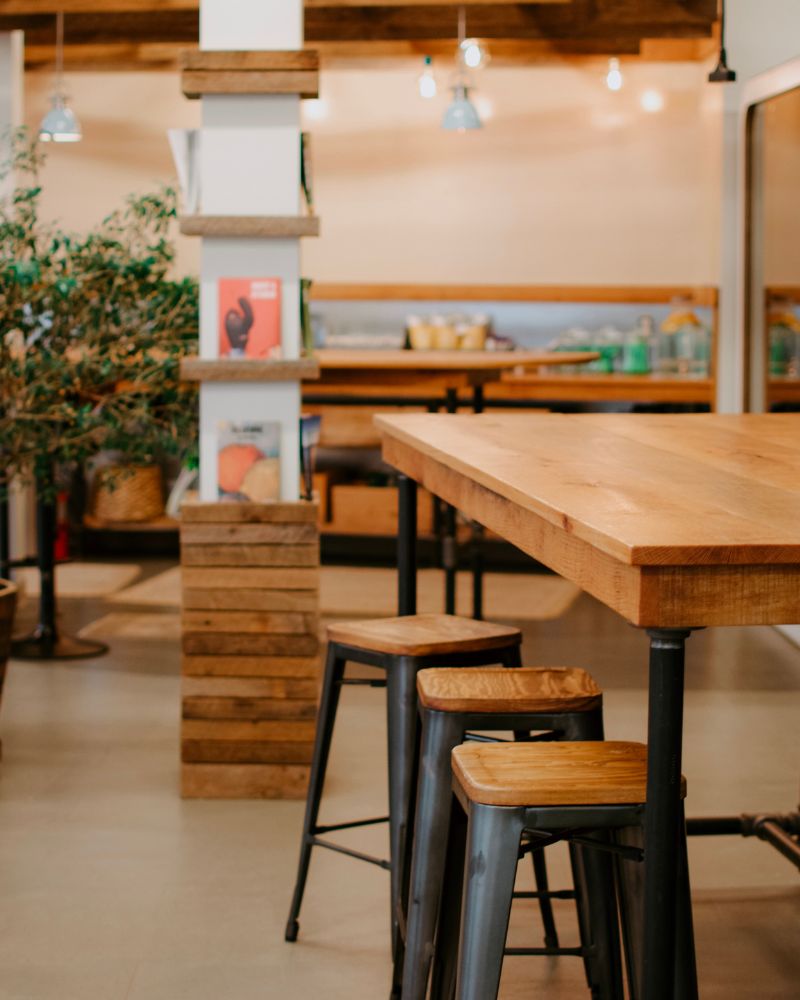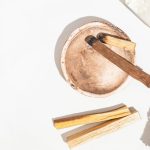People in Morocco have been practicing woodworking as a traditional craft for a long time. They have passed down this skill from parents to children over many generations. Woodworkers in Morocco make a variety of things, like spoons, ladles, serving boards, doors, and furniture. You can find woodwork all around Morocco because it is an important part of their culture.
But it doesn’t stop there; even the flavors of Moroccan food have an origin story rooted in this ancient art form.
So let us take a journey through the history of Moroccan woodworking and explore how it became intertwined with Moroccan cuisine.
History Of Moroccan Woodworking
Woodworking is a special craft in Morocco that has been around for a long time. They pass it down from one generation to the next, making it an important part of their culture. Each region has its unique way of doing woodworking that is specific to its needs and traditions.
Moroccan carpenters use a set of essential tools for their work. These tools include planes, saws, chisels, and gouges. They use special tools to make very detailed patterns and connect pieces in a clever way. They also use these tools to make delicate things like the legs of furniture and small boxes. Each tool requires special skills and techniques that artisans learn over time.
As time has passed, old ways of woodworking have combined with new ways to create special and one-of-a-kind designs. Moroccan craftsmen are open to new ideas and innovation, blending old and new styles. They combine traditional craftsmanship with modern materials and finishes to create beautiful pieces.
Today, you can see the artistry of Moroccan woodworking in different forms, from furniture to kitchenware. It gives us a glimpse into the rich history of woodworking in Morocco and how it continues to evolve and be a part of their culture.
The Tools Of The Trade
Artisans in Morocco have been passing down the skill of woodworking from one generation to the next for many years. It involves using special techniques to create beautiful things out of wood. Woodworkers in Morocco use a combination of old and new techniques to create furniture, decorations, and useful items. They sometimes even use metal along with wood to make their creations.
The designs they create are so detailed and fancy that they have influenced Moroccan cooking too. They make special wooden utensils for cooking, like spoons and ladles, with cool designs on the handles. Even chefs use big wooden dishes, like tagines and platters, that they carve and inlay with metal to serve food. These pieces look amazing and make the dining experience more special when you use them to share food with your loved ones.
Utensils And Kitchenware

Moroccan woodworking has been part of the country’s culture for a very long time. It involves making useful things for the kitchen using wood. One example is wooden spoons, which come in different shapes and sizes and are great for stirring and mixing. People can find carved bowls in markets or stores, and they are also popular. They are unique and can be a good topic of conversation when having guests over. Moroccan woodworkers also make ladles, spatulas, serving spoons, and trays. They use natural woods like cedar, olive, or eucalyptus trees from Morocco’s forests.
Artisans make each piece by hand using traditional methods to ensure they last a long time. These handmade kitchen items are not only beautiful but also practical for everyday use. Having a genuine Moroccan piece in your home adds charm and functionality to your dining table.
With this in mind, let us explore the next topic: wooden serving boards!
Wooden Serving Boards
Moroccan woodworking is an amazing art form, with a wide variety of wood types used to create beautiful serving boards.
From olive and cedar woods to walnut and ebony, each one gives off a unique look and feel that makes it one-of-a-kind.
Design variations range from traditional and rustic to modern and sleek, so there’s something for everyone!
As a bonus, wooden boards are a great way to showcase traditional Moroccan cuisine.
Types Of Wood
Wood is an integral part of Moroccan woodworking and cuisine.
Choosing the right kind of wood is important when making beautiful serving dishes and other kitchen items. There are different types of wood to choose from, like cedar, pine, walnut, and mahogany. Each wood has its strength and looks nice.
To enhance the beauty of the wood, craftsmen can use different techniques. For example, staining and varnishing can bring out the wood’s natural beauty. Carving by hand can also create intricate designs on the surface, making it even more special.
With a little bit of effort, you’re sure to find something that will add character and style to any mealtime ritual!
Design Variations
Wooden serving boards are a popular choice in Moroccan culture for presenting food. They look nice and have cultural meaning.
When choosing a serving board, it’s important to think about the different designs available and how to take care of them.
A high-quality board will last a long time with proper care, but cheaper ones may not be as durable. So, finding the right serving board is important!
Carved Doors And Furniture
People in Morocco have been using wooden serving boards in their cuisine for a long time. They are handmade with great care and have beautiful designs.
But Moroccan woodworking is not about serving boards. It includes carving designs on doors and furniture too. They use strong and durable woods like teakwood, cedar, and juniper. Artisans make designs on wooden serving boards with precise cuts, and each design has a special meaning.
Nowadays, more people show interest in Moroccan crafts and seek to learn about their rich history. This helps local artisans share their creations worldwide and keep ancient traditions alive.
Next, we will learn about how spices make Moroccan dishes even more delicious!
Spices For Moroccan Dishes
In Moroccan cooking, they use special spices like cumin, ginger, turmeric, paprika, cinnamon, and cardamom. These spices make the food taste good! These spices make the food taste good and are often mixed to create yummy flavors.
There are also other spices like coriander, saffron, pepper, garlic, cilantro, caraway, mustard, harissa, and ras el hanout.
These spices are also used, but their prices can vary depending on where you buy them.
I love to use a combination of all these spices to create a unique flavor in my dishes. It’s amazing how a few simple ingredients can bring a dish to life – that’s the power of Moroccan woodworking and cuisine!
Cumin
Ah, cumin – the signature spice of Moroccan cuisine! As a woodworker from Morocco, I’ve seen how this powerful flavor has become intertwined with our culture. It’s often used to enhance grain dishes and is even found in traditional tea recipes.
Of course, when you think of cumin, the first thing that comes to mind is its pungent aroma and distinct flavor. With a pinch or two, it can transform any dish into something special!
You can do so many things with cumin! Sprinkling some ground cumin on couscous makes it taste nutty and smoky. And in Morocco, they even make cumin tea to help with digestion after eating yummy grain dishes.
Adding spices too like cinnamon, ginger, and cardamom to warm milk creates a tasty drink that will make your mouth water!
No matter what type of food you’re cooking up in your kitchen, don’t forget to add some cumin – it’ll take any recipe from good to great!
Ginger
Ginger is a special spice used in Moroccan recipes. It adds a great smell and taste to both sweet and savory dishes. We love using it in our tea, ginger beer, and even ginger snaps!
But ginger is not only delicious, but it’s good too for your health. It can help make any swelling in your body go down, help you digest your food better, and make your immune system stronger. So, it’s like a super spice that’s good for your body! So, it’s not only yummy, it’s good for you too!
So don’t feel guilty when reaching for an extra pinch or two of this amazing spice – it could very well do wonders for your health!
No matter what type of food you’re cooking up in the kitchen, adding some fresh ginger is sure to take your recipe from good to great!
Turmeric
Turmeric is a special spice that we use a lot in Moroccan cooking. It has a bright yellow color and a yummy earthy taste. We’ve been using it for a very long time to make our dishes more colorful and tasty.
But turmeric is not only for cooking! We also use it to make beautiful decorations on things like wooden furniture. It makes our projects unique and special.
The best part is that turmeric is good for you too! It can help reduce swelling in your body and keep your immune system strong. So when we add turmeric to our recipes, we’re not only making them delicious, but also healthy!
Traditional Recipes
In Morocco, woodworking and cooking go hand in hand. People use wood to make furniture and tools, and this has influenced how they cook and present their food.
Moroccan food tastes good because they use a lot of different spices. These spices make the food flavorful and delicious. Some of the spices they use are cumin, turmeric, paprika, saffron, cloves, cinnamon, ginger, and garlic. These spices give Moroccan dishes their special taste. These spices make the food taste good, whether it’s meat stews or vegetable salads. People also use a lot of fresh fruits and vegetables to make colorful and delicious dishes all year round!
Some popular staples include:
- Tajine: it’s a yummy meal cooked in a pot. They put meat like chicken or lamb and add vegetables like potatoes, carrots, olives, and raisins. All these ingredients cook together to make a tasty and hearty stew.
- Couscous: steamed semolina grains served alongside vegetables or meat;
- Harira Soup: a hearty soup made with lentils, chickpeas, and tomatoes;
- Bessara: a thick dip usually served with warm bread at breakfast time;
In Morocco, the food they make came from two things: the delicious ingredients they use and the old ways they work with wood. This connection between making things with wood and cooking is important in Moroccan culture. Now let’s talk about the tools they use for cooking – they are very important in how they make their delicious meals.
Cooking Utensils
Skilled woodworkers make special tools for cooking that Moroccan cooks use. They have utensils like tagines, which are big pots made of copper. They also use wooden spoons for stirring sauces and soups.
These tools come with beautiful designs that show off the skills of Moroccan craftsmen. Different cultures in Morocco use different materials for their utensils. The Berber culture, for example, uses metals like iron and brass to make utensils of different sizes and shapes. Copper is also popular because it spreads heat when cooking. Wooden spoons made from olive trees are becoming more popular because they are strong and look nice.
These utensils are important for making tasty meals because they bring out the flavors in the food. Moroccan chefs use them to create authentic dishes that reflect the country’s culinary heritage. Many Moroccans are proud to use these special tools in their kitchens or restaurants.
Next, we will learn about how the Berber culture has influenced Moroccan cuisine.
The Influence Of Berber Culture
For centuries, Berber culture has played a big role in Moroccan woodworking and cuisine. They create beautiful carvings and use spices in their recipes, keeping their traditions alive.
Here are some examples:
- Intricate carvings: In Morocco, many skilled artists carve beautiful designs into wood. They learned this skill from their ancestors, the Berbers, who were also very good at carving. They used their talent to make furniture, doors, windows, and decorations for gardens. These carvings have special meanings and symbols that are important to the Berber culture.
- Bazaar shopping: In Berber tradition, people go to local markets called “souks” to buy fresh ingredients for their cooking. They get things like dates, olives, saffron threads, and lemons, which are important ingredients in Moroccan dishes.
- Cooking methods & flavors: In Berber cooking, they take their time to cook food. This slow-cooking method helps make the flavors in dishes like tagines and couscous more delicious and rich.
We can use modern tools like 3D printers and laser cutters to help keep the ancient art of carving alive. This way, we can still enjoy beautiful and meaningful creations while enjoying tasty Moroccan food.
Preserving The Art Of Woodworking
Woodworking has always been important in Moroccan culture for a long time. It’s not only a practical skill, but it also has a special meaning. We need to protect this craft to preserve the history it represents.
The art of woodworking is also seen in Moroccan cooking. Local potters use clay pots to cook traditional dishes like tagines. People also use wood to make spoons and skewers that add flavor and texture to foods like couscous and tajine.
When we protect both woodworking and cooking traditions, we honor the unique culture of Morocco. These ancient practices have stories and traditions that go back many years. By keeping them alive, future generations can enjoy and understand their heritage even better.
Frequent-Asked Questions
What Materials o Moroccan Woodworkers Use For Their Craft Besides Wood?
Do Moroccan woodworkers use only wood for their creations?
No, Moroccan woodworkers use more than wood! They also use recycled glass and metal to make furniture. They get the cork from Portugal, which they use for things like kitchen utensils and decorations. And sometimes they even weave fabrics like cotton and jute rope into the wooden pieces to make them look and feel special.
Moroccan artisans are good at using different materials together with wood to make amazing artwork!
What Are The Environmental Impacts Of Woodworking In Morocco?
When it comes to woodworking in Morocco, sustainable harvesting and local sourcing are top of mind.
Moroccan artisans are good at carving wood to make furniture and decorations. But they need to be careful because cutting down too many trees can hurt the environment and make it harder to get the wood they need.
To protect the planet, people in Morocco have to find ways to cut down trees while still keeping this important tradition alive. It’s important to balance their cultural craft with taking care of nature.
What Are The Cultural And Religious Implications Of Moroccan Woodworking?
People have passed down the special craft of Moroccan woodworking from parents to children for a long time. It has a lot of meaning for Moroccans because it represents their culture and beliefs.
The wooden furniture they make is not only for decoration, but it also has symbols and meanings behind it. Even everyday items like cutting boards and spoons have a special place in their traditional kitchens.
People who do this craft use it as a way to show how much they care about their culture and religion.
Moroccan woodworking is like making special things out of wood that show how much people care about their culture and beliefs. They use their skills to create beautiful wooden objects that represent their heritage and what they believe in. It’s a way for them to show their love and respect for their traditions.
How Has Moroccan Woodworking Changed Over The Years?
Moroccan woodworking has been around for a long time and it has changed with the modern world.
Craftsmen use special tools to make all kinds of things like boxes, tables, and chairs. They make these things beautiful and useful at the same time.
Each piece they make is different and shows how good they are at their craft. They have been making things this way for a very long time.
How Can We Promote The Preservation Of Moroccan Woodworking Traditions?
It’s important to keep the traditional ways of Moroccan woodworking alive for future generations.
We need to make a place where people can learn about and appreciate these traditions. Workshops or classes can teach people how to do Moroccan woodworking so they can carry it on.
We should also show how woodworking connects to other parts of Moroccan culture like food, history, and music. This will help people understand why it’s so special.
For many years, Moroccan woodworking has been an important part of the country’s culture. It has a big influence on the food we eat in Morocco.
Artisans in Morocco use wood to make beautiful decorations for our traditional dishes. They also make spoons for stirring spices and other things we use in cooking. Their work is very special and adds to our food traditions.
We need to make sure we keep this craft alive for the future. We can do this by supporting the local artisans who make these wooden items and by being careful about how we use wood so that it doesn’t run out.
Let us commit ourselves to preserving these ancient crafts so they may continue to inspire us with their beauty and flavor!







